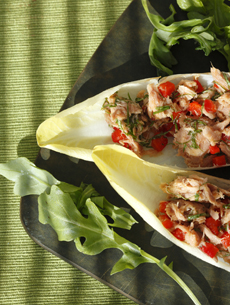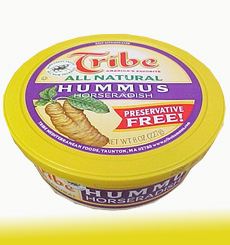| Is your goal to pursue a healthier lifestyle in 2011?
It’s a challenge, since the diet for many of us is too high in saturated fats. (America’s two favorite foods, burgers/cheeseburgers and pizza, are full of them). The processed foods most of us eat too much of are full of salt and sugar. And our diets are too low in key nutrients such as omega-3 fatty acids and vitamin D.
When searching for easy solutions, one need look no further than the sea. Fish and seafood are natural sources of the nutrients we need the most. They’re in a food group that both adults and children should eat more of.
Most likely, you know this.
But since it’s Healthy Food Month at THE NIBBLE, we want to remind you that groups such as the Food and Agriculture Organization of the United Nations and World Health Organization recommend the benefits of eating fish for heart health in adults and brain development in babies.
|
|

This easy high-protein snack, lunch dish or
appetizer uses Star Kist Yellowfin Tuna in
heart-healthy extra virgin olive oil. Photo
by Katharine Pollak | THE NIBBLE. |
| FIVE FACTS ABOUT FISH THAT MIGHT SURPRISE YOU
According to Jennifer McGuire, MS, RD at the National Fisheries Institute (NFI) and blogger of seafood recipes:
1. You Cannot Eat “Too Much” Seafood
”For the general population there are no types of commercial or store-bought seafood to limit or avoid,” says McGuire. According to the FDA, the dietary goal is to eat a variety of seafood 2-3 times a week, but few Americans meet this goal. On average, Americans eat fewer than three ounces of seafood a week, compared to the recommended 8-12 ounces. NEW YEAR’S GOAL: Triple or quadruple the amount of fish you eat to meet the recommendation. Add shrimp and scallops to pasta, omelets and salads; eat more sushi and sashimi; grill fish twice a week.
2. Dietary Supplements Only Provide Partial Health Benefits
According to McGuire, fish oil supplements are not an equal substitute to eating fish as a whole food. “A variety of seafood will give your body omega-3s, lean protein, vitamins including B and D, iron, calcium, and more,” says McGuire, “whereas a fish-oil pill stops at omega-3s.” Supplements are not a complete trade-off. Oily fish like tuna, salmon, mackerel and sardines are some of the top omega-3 sources. NEW YEAR’S GOAL: Serve tuna and salmon at least once a week. It’s easy to pan-fry, poach or grill salmon and toss canned tuna into hundreds of recipes. If you think you don’t like mackerel and sardines: Look for fresh sardines—delicious grilled—and try mackerel at sushi bars. Raw mackerel is mild and not “fishy” like the cooked version.
3. Developing Babies Need Nutrients Found In Fish
The 2004 FDA recommendation for pregnant women and nursing mothers states, “Fish and shellfish contain high-quality protein and other essential nutrients, are low in saturated fat, and contain omega-3 fatty acids. A well balanced diet that includes a variety of fish can contribute to heart health and children’s proper growth and development. So, women and young children in particular should include fish or shellfish in their diets due to the many nutritional benefits.…” There are just four fish varieties that this target audience should avoid as they aim for 2-3 seafood meals a week: shark, swordfish, king mackerel and tilefish, all of which have mercury levels.
4. Marine Foods Are The Only Naturally Rich Food Sources Of Omega-3 Fatty Acids
The type of omega-3s linked to heart and brain health (DHA and EPA) are only found in marine foods. McGuire notes, “The omega-3s in plant foods like walnuts, canola oil and flaxseed are healthful, but less powerful than the type in seafood. The body has a hard time converting plant-based omega-3s to DHA and EPA, so there isn’t really a substitute for seafood.”
5. Canned Seafood Counts
Fish in all forms, as long as it is prepared in a healthy way, counts toward the 2-3 servings per week goal. “I eat a lot of canned and pouch tuna, salmon, and sardines along with frozen and fresh fish,” says McGuire.
New year, new opportunity to eat better: There is no better time to include seafood in your diet than now.
|





